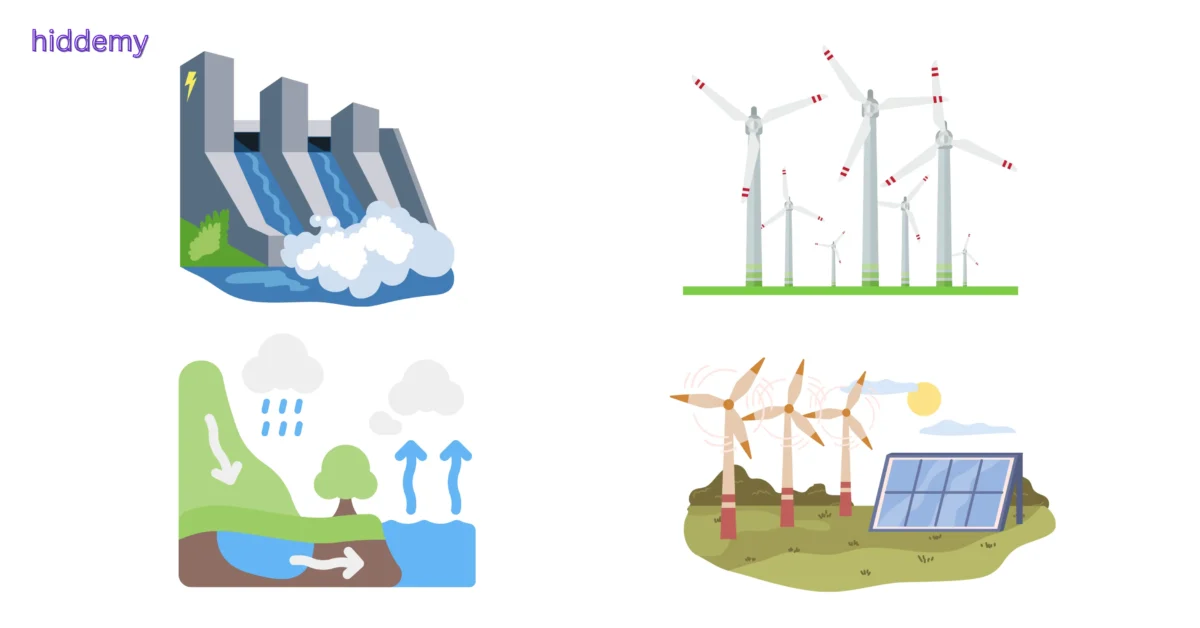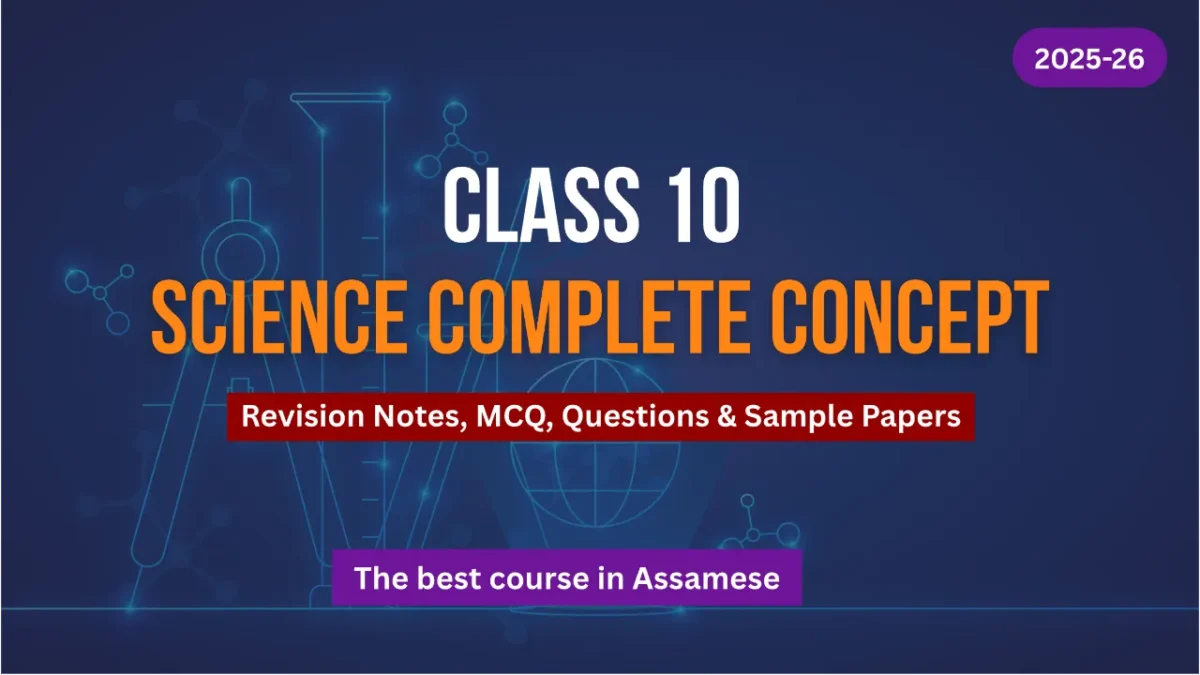SEBA Class 10 Science Chapter 14 Notes: Sources of Energy | শক্তিৰ উৎস
Class 10 Science Chapter 14 Notes Sources of Energy (শক্তিৰ উৎস) for HSLC 2026
Class 10 Science Chapter 14 Notes Sources of Energy are essential for SEBA students preparing for HSLC 2026. These notes help you understand different forms of energy, focusing on Renewable Energy Sources, Non-Conventional Energy, and Green Energy. Each topic is explained in simple Assamese, making complex ideas easier to grasp.
These Class 10 Science Chapter 14 Notes Sources of Energy cover important concepts such as solar energy, wind energy, hydropower, biomass, and nuclear power. You'll also learn about the harmful effects of using fossil fuels, including pollution and climate change. Topics like sustainable development and Green Energy are discussed in detail.
Prepared as per the SEBA syllabus, Class 10 Science Chapter 14 Notes Sources of Energy also highlight the need for Renewable Energy Sources to protect the environment. Non-Conventional Energy solutions are becoming vital in today's world, and these notes explain their role with simple examples and diagrams.
To prepare smartly for your board exam, refer to these Class 10 Science Chapter 14 Notes Sources of Energy. You can also revise important questions by visiting the Class 10 Science Chapter 14 Q&A page.
SEBA Class 10 Science Chapter 14 Notes: Sources of Energy | শক্তিৰ উৎস
✦ শক্তিৰ পৰিচয় (Introduction to Energy)
শক্তি বিভিন্ন ৰূপত থাকে আৰু ইয়াক এটা ৰূপৰ পৰা আন ৰূপলৈ ৰূপান্তৰিত কৰিব পাৰি। শক্তি হৈছে কাৰ্য সম্পাদনৰ ক্ষমতা।
শক্তিৰ প্ৰয়োজন (Need for Energy)
- খাদ্য প্ৰস্তুত কৰিবলৈ
- পোহৰৰ বাবে
- পৰিবহনৰ বাবে
- মেচিন চলাবলৈ
- উদ্যোগ আৰু কৃষিকাৰ্যৰ বাবে
- দৈহিক কাম কৰিবলৈ
শক্তিৰ ভাল উৎসৰ গুণ (Characteristics of a Good Energy Source)
- প্ৰতি একক আয়তন বা ভৰৰ বিনিময়ত সৰহ পৰিমাণৰ কাৰ্য সম্পাদন কৰে।
- সহজেই উপলব্ধ।
- সঞ্চয় আৰু পৰিবহন সহজসাধ্য।
- মিতব্যয়ী; ই সম্ভৱতঃ শক্তিৰ উৎসৰ আটাইতকৈ গুৰুত্বপূৰ্ণ ধৰ্ম।
ইন্ধন (Fuel)
- যিবোৰ পদাৰ্থ জ্বলাই তাপশক্তি উৎপন্ন কৰা হয়।
- উদাহৰণ: কাঠ, কয়লা, এলপিজি, কেৰাচিন।
- ভাল ইন্ধনৰ বৈশিষ্ট্য:
- প্ৰতি একক আয়তন বা ভৰৰ বিনিময়ত সৰহ পৰিমাণৰ কাৰ্য সম্পাদন কৰে।
- সহজেই উপলব্ধ।
- সঞ্চয় আৰু পৰিবহন সহজসাধ্য।
- মিতব্যয়ী।

চিত্ৰ: শক্তিৰ উৎসৰ প্ৰকাৰ
✦ নবীকৰণযোগ্য শক্তি (Renewable Energy)
যিবোৰ শক্তিৰ উৎস অবিৰতভাৱে উৎপন্ন হৈ থাকে, অৰ্থাৎ ই কেতিয়াও শেষ নহয় অথবা পুনৰাই ব্যৱহাৰ কৰিব পাৰি তাকেই নবীকৰণযোগ্য শক্তি বোলা হয়।
নবীকৰণযোগ্য শক্তিৰ উৎসসমূহ (Sources of Renewable Energy)
- সৌৰ শক্তি (Solar Energy)
- বতাহ শক্তি (Wind Energy)
- জল শক্তি (Hydro Energy)
- ভূ-তাপীয় শক্তি (Geothermal Energy)
- মহাসাগৰীয় শক্তি (Oceanic Energy)
- জীৱভৰ (Biomass)
নবীকৰণযোগ্য শক্তিৰ লাভজনক দিশসমূহ (Advantages of Renewable Energy)
- পৃথিৱী থকালৈ এই উৎসসমূহ উপলব্ধ হৈ থাকিব।
- এই উৎসসমূহ প্ৰাকৃতিকভাৱে বিনামূল্যত উপলব্ধ।
- ই পৰিৱেশ প্ৰদূষিত নকৰে।
✦ অনবীকৰণযোগ্য শক্তি (Non-Renewable Energy)
যিবোৰ শক্তিৰ উৎস অবিৰতভাৱে উৎপন্ন নহয় আৰু এবাৰ ব্যৱহাৰ কৰাৰ পাছত পুনৰাই ঘূৰাই পোৱা নাযায় তাকে অনবীকৰণযোগ্য শক্তি বোলে।
অনবীকৰণযোগ্য শক্তিৰ উৎসসমূহ (Sources of Non-Renewable Energy)
- কয়লা (Coal)
- তেল (Oil)
- প্ৰাকৃতিক গেছ (Natural Gas)
অনবীকৰণযোগ্য শক্তিৰ অসুবিধাসমূহ (Disadvantages of Non-Renewable Energy)
- অধিক পৰিমাণে ব্যৱহাৰৰ ফলত এই উৎসসমূহ দ্ৰুতহাৰত শেষ হৈ গৈ আছে।
- এই উৎসসমূহ নতুনকৈ অৱিষ্কাৰ কৰাটো কঠিন।
- এই উৎসসমূহেই পৰিৱেশ প্ৰদূষণৰ প্ৰধান কাৰণ।
✦ পৰম্পৰাগত শক্তিৰ উৎস (Traditional Energy Sources)
জীৱাশ্মজাত ইন্ধন (Fossil Fuels)
- জীৱাশ্মজাত ইন্ধনৰ উদাহৰণ: কয়লা, পেট্ৰ’লিয়াম।
- এইবোৰ অনবীকৰণযোগ্য শক্তিৰ উৎস।
- ইয়াৰ গঠনৰ বাবে কোটি কোটি বছৰৰ প্ৰয়োজন হয়।
- ই অতি সীমিত পৰিমাণত উপলব্ধ।
- বিশ্বৰ সংৰক্ষিত কয়লাত ভাৰতৰ প্ৰায় ৬% অংশ আছে, যি বৰ্তমানৰ ব্যৱহাৰৰ হাৰত ২৫০ বছৰৰ পাছত শেষ হ'ব বুলি ঠাৱৰ কৰিছে।
জীৱাশ্ম ইন্ধনৰ ফলত হোৱা প্ৰদূষণ (Pollution from Fossil Fuels)
- কাৰ্বন, নাইট্ৰ’জেন আৰু ছালফাৰৰ অক্সাইডসমূহ আম্লিক প্ৰকৃতিৰ আৰু ইয়াৰ ফলত এচিড বৰষুণৰ সৃষ্টি হয়।
- ই জল আৰু স্থলসম্পদসমূহৰ যথেষ্ট ক্ষতি কৰে।
- বায়ুমণ্ডলত বৃহৎ পৰিমাণৰ CO₂ উৎপন্ন কৰে, ফলত সেউজ গৃহ প্ৰভাৱে বায়ুমণ্ডলৰ উষ্ণতা বৃদ্ধি কৰিছে।
জীৱাশ্ম ইন্ধনৰ ফলত হোৱা প্ৰদূষণ নিয়ন্ত্ৰণ (Controlling Pollution from Fossil Fuels)
- দহন প্ৰক্ৰিয়াৰ দক্ষতা বৃদ্ধি কৰা।
- জীৱাশ্ম ইন্ধনৰ ব্যৱহাৰ লাঘৱ কৰি বিকল্প ব্যৱস্থাৰ অনুসন্ধান কৰা (যেনে - বিদ্যুৎ চালিত পৰিবহন ব্যৱস্থা)।
🎁 Coupon Code: Gem100 ব্যৱহাৰ কৰা।
Enroll in Our Class 10 Science Course!
Unlock the full SEBA Class 10 Science Chapter 14 – Sources of Energy experience with beautifully designed diagrams, detailed notes, and expert guidance. Perfect for HSLC 2026 preparation.

Class 10 Science Detail Notes Course FAQs
Course Details
Summary: This course is a complete package for SEBA Class 10 Science. It covers Physics, Chemistry, and Biology chapters with Assamese-medium explanations, diagrams, MCQs, previous year questions, and practice sets—all in one place for HSLC 2026.
Course Benefits
Summary: Get expert-made notes, interactive quizzes, downloadable PDFs, chapter-wise videos, and exam-focused MCQs. Designed for complete understanding and high score in Class 10 SEBA exams.
What You'll Learn
Summary: You will master chapters like Sources of Energy, Heredity and Evolution, Control and Coordination, Periodic Table, etc., with topic-wise videos, animations, NCERT-based questions, and bilingual (English–Assamese) support.
Duration & Format
Summary: Self-paced online course accessible anytime. Notes and videos available 24×7 with lifetime access after enrollment. Study at your own speed!
Who Should Join
Summary: Ideal for Class 10 SEBA students (Assamese Medium), especially those preparing for HSLC 2026. Also suitable for students who want visual learning, practice materials, and full revision help.
Explore More
| Chapter | Resources |
|---|---|
| Chapter 14: শক্তিৰ উৎস | |
| Chapter 11: মানুহৰ চকু আৰু বৰ্ণিল পৃথিৱী | |
| Chapter 1: ৰাসায়নিক বিক্ৰিয়া আৰু সমীকৰণ | |
| Chapter 2: এছিড, ক্ষাৰক আৰু লৱণ | |
| Additional Resources |



